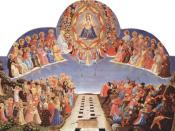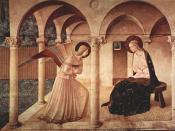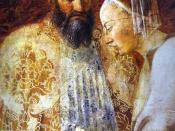The Annunciations During the Renaissance, The Annunciation was one of the more typical paintings chosen by an artist, making his rendition his own. Three quite significant renditions include Simone Martini?s The Annunciation, done with tempera on wood in 1333 in Galleria degli Uffizi, Florence, Italy; Fra Angelico?s Annunciation, done in fresco c. 1440-1445 from San Marco, Florence, Italy; and Piero Della Francesca?s Annunciation from the Legend of the True Cross, done in fresco in 1455 in San Francesco, Arezzo, Italy.
Simone Martini was known for his method, which developed into the International style consisting of brilliant color, lavish costume, intricate ornament, and themes involving splendid processions in which knights and their ladies complete with entourages, horses, and greyhounds. (Gardner?s 575) Martini most likely was aware of the work of Giotto but did not try to replicate. Martini?s Annunciation portrays an elegant and formal setting with radiant color, also flowing line and the figures seem to be floating as with no obvious type of perspective.
Some sense of movement can be noticed with the Angel (Gabriel), just alighted, seen in an elaborate gown of white and gold, and the Virgin, putting down her book of devotions, acting with correct etiquette in presence of royalty. The rich blue of her gold hemmed gown brings across a sense of holiness being colors she wears as the Queen of Heaven. Aside from the painting, the frame could be considered a work of art in itself. It is a late Gothic, French inspired masterpiece that strays from typical Italian renaissance work. This combined with the painting have helped to establish this new International style, making Martini a true renaissance artist, improving upon old and inventing new ways of going about things.
The Dominican painter-monk, Fra Angelico was very conservative in his methods. He...


